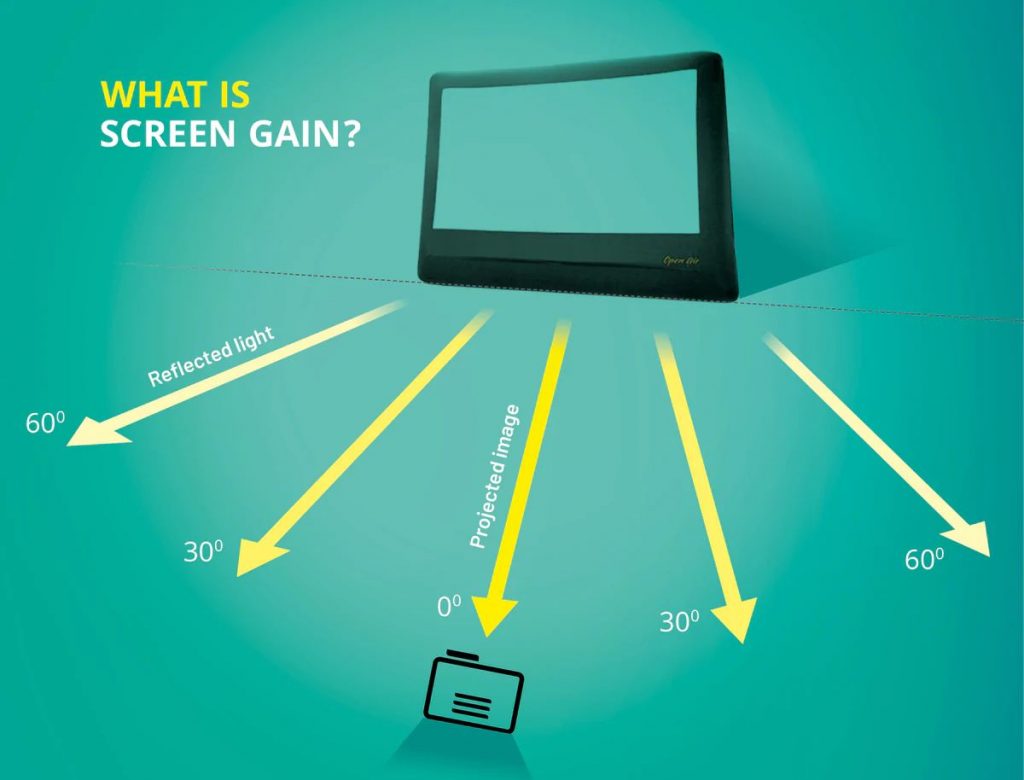Since you are here, you probably have come across the term “screen gain”, and you want to learn more about what it means. Most projector companies calibrate their products to a white screen right out of the factory, delivering ideal contrast rates and lumen for any white screen.
So, when you are looking for a good projector, there are a few things that you’ll need to know, and one of them is to find out what is gain on projector screen.

What Is Gain on Projector Screen?
The most simple definition of what is gain on projector screen is the reflectivity of the projector screen at zero viewing angle. As you probably already know, projectors project images, and those images have a certain level of brightness. Every screen has a gain factor, and the industry standard is 1.0. Screen gain is measured by comparing the light of a standard white screen reflection.
If you want to know more about projector screen gain, which level is ideal, and how to measure it yourself, keep reading.
Read more: What to Look For in a Projector Screen?
Gain on Projector Screen? – Let’s Get Into Details!
What it means
One thing about making the most of your projector is understanding what “gain” means. If you are still wondering why this is important, I will explain this further in this article.
As you might already notice, the projector directly reflects light from the screen to the viewer’s eyes, and the gain is the exact level of reflected brightness. With this in mind, knowing the exact amount of reflectivity is vital if you want to experience a brighter image and a much higher-quality viewing angle.
It’s measured by the ratio of the light that the screen is reflecting in comparison to the light that a standard whiteboard is reflecting. Any screen surface has its own gain number relative in correspondence to international standards.
Measuring screen gain – what is better, higher or lower?
From a professional perspective, the best way to measure a projector screen gain is by taking a center viewpoint where the projector reflects its brightest point. Another way to measure is by the side, called the “half gain angle” from this level, the brightness of the light drops by half.
According to the industry standard, the average gain level is 1.0, where the reflected gain’s brightness is visible from all sides identically to the amount of light reflected by a whiteboard.
So the real question pops here, what is the ideal gain, high or low? Each option has its good and bad sides, and I’ll be listing them down below.
High gain level – benefits and drawbacks
The high gain levels are better in terms of more extensive visibility with low-lumen projectors, especially for the dark conditions on the screen. The image looks clearer and more visible, increasing the reflection of the projector to make them look powerful.
On the other hand, one of the biggest issues with high gain levels is “hot spotting“, which means that the image will appear brighter in comparison to the outer edges when viewed from a zero-degree angle.
Summarizing this, brighter doesn’t always mean better, mainly because the brighter image for those sitting in the cone means a diminished brightness for those located outside. What this means is that you’ll need a smaller area for the entire audience to experience the maximum brightness.
Low gain level – benefits and drawbacks
Low-gain level projectors are usually preferred for home theater environments as they come with a better viewing range, especially for dark and gray screens, as it reduces the brightness allowing you to get a clearer view.
Some of the disadvantages of low gain levels are that they aren’t very practical when it comes to an outdoor cinema because they are low on brightness, and the insufficient contrast makes them difficult and tiring on the eyes.
Fabric gain – ideal for most purposes
Fabric gain of 1.0 is considered to be the ideal gain for many purposes since it gives an ideal brightness level. The higher gain should only be used if the projector isn’t that powerful or if you specifically want a brighter picture.
On the other hand, if you want to reduce the reflection, especially in rooms with very strong ambient light, it’s recommended to use lower screen gain. It’s also used to produce a darker picture by optimizing the contrast ratio.
Also read: What Color Screen Is Best for a Projector?
How do I measure my protector screen gain
Measuring the screen gain in the theater is not practical; however, one of the ways to do it is to look at the screen specification sheets and the geometry of the seats. Once you calculate these two, you can determine the average screen gain.
Measuring the screen game requires special equipment that’s pretty expensive; however, there is an alternative method that can help you to get a rough result. I have found an interesting theory that the human eye can easily detect the difference between 1 gain and 1.3 gain.
If the gain screen looks brighter than 1, it may be 1.1 or 1.2.; similarly, if it’s dimmer, it can be 1.3.
Front and rear projector gain – the main difference
The front projections screen gain has the greatest impact on the viewing angle. What this means is that the further the audience is, the more distorted image they will see. On the other hand, the angle is not as important as the rear projections; however, in this case, you’ll need to consider the material of the projector if you want to achieve high-quality and clear images.
Whenever you are wondering which option is preferable, consider the ambiance and the effect you want to achieve. With rear projection, you’ll achieve a more professional and high-end effect, while front projections won’t make you achieve that professional effect.